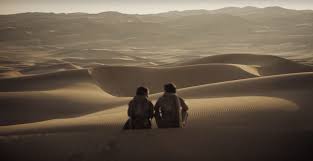🎬 Dune: Part Two

Plot Overview
Dune: Part Two resumes immediately after the events of its predecessor, with Paul Atreides (Timothée Chalamet) and his mother, Lady Jessica (Rebecca Ferguson), stranded on Arrakis after House Atreides’ betrayal by House Harkonnen and the Emperor (Christopher Walken). The film opens in the desert, where Paul and Jessica are rescued by the Fremen, the planet’s native inhabitants, led by Stilgar (Javier Bardem). Stilgar believes Paul may be the prophesied Lisan al-Gaib, a messiah destined to liberate Arrakis, though Paul resists this mantle, haunted by visions of a holy war sparked by his leadership.
Paul integrates into Fremen life, training under Chani (Zendaya), a fierce warrior he’s fallen for, and learning their ways—riding sandworms, harvesting spice, and surviving the harsh desert. Meanwhile, the Harkonnens, under the sadistic Baron Vladimir (Stellan Skarsgård) and his nephew Feyd-Rautha (Austin Butler), tighten their grip on Arrakis, exploiting its spice trade with ruthless efficiency. Jessica, pregnant with Paul’s sister Alia, undergoes a Fremen ritual, drinking the Water of Life—a potent spice essence—to become a Reverend Mother. The ordeal amplifies her prescience, and she begins sowing the messiah myth among the Fremen, amplifying Stilgar’s fervor despite Paul’s objections.
The plot escalates as Paul’s visions—of a galaxy engulfed in jihad—grow darker. He reluctantly takes the Water of Life himself after a near-fatal attack, unlocking his full prescience and confirming his lineage as a product of the Bene Gesserit breeding program, tying him to both Atreides and Harkonnen blood. Empowered, Paul unites the Fremen tribes, launching a guerrilla war against the Harkonnens—raiding spice harvesters and toppling outposts with sandworm-mounted assaults. The Emperor arrives on Arrakis with his Sardaukar troops and Bene Gesserit handler, Lady Margot (Léa Seydoux), to crush the uprising, setting the stage for a climactic showdown.
In the final act, Paul orchestrates an attack on Arrakeen, the capital, using atomics to breach its shields—a taboo act signaling his willingness to embrace power at any cost. He kills the Baron, defeats Feyd-Rautha in a brutal duel, and confronts the Emperor, demanding the throne by marrying Princess Irulan (Florence Pugh) to secure peace. Chani, betrayed by Paul’s shift from lover to messiah-king, rejects his choice and rides off into the desert on a sandworm, leaving their future uncertain. The film ends with Paul’s ascension as galactic ruler, his visions of war unfolding as Fremen ships launch into the stars, igniting the jihad he feared.
Jon Spaihts, Denis Villeneuve, and Eric Roth’s screenplay condenses Herbert’s dense latter half into a 166-minute epic, balancing political intrigue, spiritual undertones, and visceral action. While it streamlines subplots—like the Spacing Guild’s role—it retains the novel’s moral ambiguity, framing Paul’s triumph as a tragic inevitability rather than a heroic victory.

Character Dynamics and Performances
Timothée Chalamet’s Paul Atreides anchors Dune: Part Two, evolving from the reluctant noble of the first film into a burdened leader. Chalamet’s wiry frame belies a commanding presence—his quiet intensity in early Fremen scenes gives way to a steely resolve as he embraces his destiny. His chemistry with Zendaya’s Chani is the emotional core; their romance—tentative glances over spice-stained sands, tender moments amid war—grounds Paul’s arc. Chalamet shines in the Water of Life sequence, his voice trembling then roaring as he unlocks his powers, though some critique his stoicism as too restrained for the role’s mythic weight.
Zendaya’s Chani emerges as a co-lead, her expanded role a departure from the book’s sidelines. She’s a skeptic to Stilgar’s zealotry, her love for Paul clashing with her disdain for the messiah myth Jessica propagates. Zendaya’s understated ferocity—whether she’s sniping Harkonnens or staring down Paul’s betrayal—makes Chani a standout, her final sandworm ride a silent gut-punch of defiance. Rebecca Ferguson’s Jessica is chillingly magnetic, her transformation into a manipulative Reverend Mother marked by a shift from maternal warmth to eerie conviction. Ferguson’s raspy chants and unblinking gaze sell the character’s descent, though her reduced screen time in the second half limits her impact.
Javier Bardem’s Stilgar brings humor and heart, his wide-eyed faith in Paul contrasting Chani’s pragmatism. Bardem’s delivery—“The Mahdi is too humble to admit he’s the Mahdi”—is both funny and poignant, grounding the Fremen’s spirituality. Austin Butler’s Feyd-Rautha is a revelation, shedding Elvis for a bald, snarling psychopath—his guttural voice and predatory swagger make him a worthy rival, his arena fight a visceral highlight. Stellan Skarsgård’s Baron remains a grotesque puppetmaster, oozing menace despite less dialogue, while Florence Pugh’s Irulan and Christopher Walken’s Emperor add regal gravitas in brief roles, their scenes hinting at political machinations cut for time.
The ensemble’s dynamics—Paul and Chani’s love versus Jessica and Stilgar’s dogma—drive the tension, though supporting players like Josh Brolin’s Gurney Halleck (returning for a rousing reunion) and Dave Bautista’s Rabban feel underused, their arcs sidelined for the central quartet. The performances elevate a dense script, humanizing Herbert’s sprawling saga with raw emotion and subtle interplay.

Direction and Visual Style
Denis Villeneuve’s direction in Dune: Part Two is a triumph of scale and subtlety, cementing his mastery of cinematic spectacle. Building on the first film’s austere beauty, he crafts Arrakis as a living, breathing world—sand dunes ripple under twin moons, spice glitters like gold dust, and sandworms erupt with primordial fury. Cinematographer Greig Fraser’s palette is stark yet rich: ochre deserts, inky Harkonnen blacks, and Fremen sietch greens create a visual tapestry that’s both alien and tactile. The film’s IMAX framing amplifies its grandeur—worm-riding sequences fill the screen with thunderous awe, the camera hugging Paul’s perilous ascent.
Villeneuve’s pacing is deliberate, balancing quiet character beats with explosive action. The opening ambush—Fremen saboteurs slicing through Harkonnen troops under a sandstorm—is a masterclass in tension, while Feyd-Rautha’s black-and-white Giedi Prime arena fight channels gladiatorial brutality with a surreal edge. The climax in Arrakeen, with atomics shattering shields and sandworms storming the city, is relentless yet coherent—every frame serves the story, avoiding CGI chaos for clarity. Villeneuve’s use of silence—Chani’s wordless departure, Paul’s haunted stares—cuts deeper than dialogue, letting the visuals speak.
Hans Zimmer’s score is a sonic juggernaut, its pounding drums, wailing vocals, and distorted synths amplifying the film’s mythic weight. Tracks like “Worm Ride” rumble with bass that shakes theaters, while softer cues—like harp notes during Paul and Chani’s romance—offer fleeting respite. The sound design—sand grinding, thumpers pulsing, worms roaring—immerses you in Arrakis’ harshness. Production designer Patrice Vermette and costume designer Jacqueline West deepen the worldbuilding: Fremen stillsuits glisten with sweat, Harkonnen armor gleams with menace, and Paul’s final cloak carries regal gravitas.
Villeneuve sacrifices some of Herbert’s philosophical tangents—Alia’s birth, the Guild’s schemes—for a leaner narrative, a choice that tightens the film but irks purists. His vision prioritizes atmosphere over exposition, trusting the audience to feel Arrakis’ stakes rather than overexplaining them. It’s a bold, immersive adaptation that dares to be both epic and intimate.

Overall Impact and Reception
Dune: Part Two roared into 2024 as a cinematic event, grossing $714.4 million worldwide against a $190 million budget—outpacing its predecessor and ranking among the year’s top earners. Critically, it’s a juggernaut, with a 92% on Rotten Tomatoes and an 8.6/10 on IMDb, hailed as a rare sequel that surpasses its original—Variety called it “a sand-blasted masterpiece.” It swept awards buzz, earning 10 Oscar nominations in 2025 (winning 6, including Cinematography and Score) and cementing Villeneuve’s status as a sci-fi titan. Audiences gave it an A CinemaScore, reflecting broad appeal beyond book fans.
The film’s impact lies in its ambition—it’s a blockbuster that respects its audience, weaving Herbert’s dense mythology into a visually stunning, emotionally resonant epic. Chalamet and Zendaya’s star power drew younger viewers, while Villeneuve’s craft satisfied cinephiles craving substance over flash. It deepened the Monsterverse’s cultural footprint, sparking renewed interest in Herbert’s novels (Dune Messiah sales spiked) and greenlighting a third film for 2026. Its exploration of power, faith, and colonialism—Paul’s rise as a white savior turned tyrant—resonated in a politically charged era, though some criticized its streamlined take on the Fremen’s culture.
For 2024 audiences, Dune: Part Two was a spectacle worth the wait (delayed from 2023 by strikes), a theatrical experience that demanded IMAX screens—sandworms alone justified the ticket price. Its flaws—undercooked side characters, a rushed ending—pale against its strengths: a visionary adaptation that balances scale with soul. It’s not perfect Herbert, but it’s pure Villeneuve—a towering, sand-swept saga that leaves you craving the next chapter, even as Chani’s solitary ride lingers like a warning.











